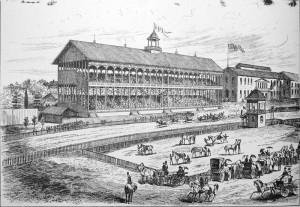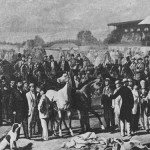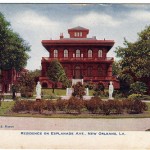 In 1847, when the Mexican War broke out, New Orleans was the leading horse-racing center of the United States. The city boasted four tracks, three on the east side and another across the river. These were the Metairie, the Eclipse, the Union, and the Bingaman, and the newspapers gave about equal coverage to the doings at the tracks as to the war with Mexico. The first racetrack Was laid out in 1820 by F’rancois Livaudais on his Live Oak Plantation, which was near the intersection of St. Charles and Washington avenues. Livaudais invited his friends to view informal matching and racing. Then followed the Jackson Course in 1825, established a few miles below the city,
In 1847, when the Mexican War broke out, New Orleans was the leading horse-racing center of the United States. The city boasted four tracks, three on the east side and another across the river. These were the Metairie, the Eclipse, the Union, and the Bingaman, and the newspapers gave about equal coverage to the doings at the tracks as to the war with Mexico. The first racetrack Was laid out in 1820 by F’rancois Livaudais on his Live Oak Plantation, which was near the intersection of St. Charles and Washington avenues. Livaudais invited his friends to view informal matching and racing. Then followed the Jackson Course in 1825, established a few miles below the city,
and, in 1837, the Eclipse Track, occupying part of the site of Audubon Park, was laid out. The next year saw the beginning of the Metairie Race Track seen here during spring meeting. From Frank Leslie’s Illustrated Newspaper, May 4, 1872.
The main entrance to the Metairie Race Course. In 1853, the Metairie Jockey Club was founded. This exclusive organization took over the management of the track, built a massive grandstand, and soon the Metairie course became a shrine for the outstanding’ thoroughbreds of the day, as well as a mecca for horsemen from all over the United States. The ten years before the Civil War was a decade forming one of the most glorious pages in the annals of American turf, and in this period Metairie attained its full glory. Crowds exceeding twenty thousand filled the stands and lined the rails. From Frank Leslie’s Illustrated Newspaper, December 18, 1869.
The racer Lexington, who provided some of the best-remembered races at the Metairie track in the thrilling Lexington-Lecompte contests in 1854 and 1855. Lecompte, foaled ana reared in Louisiana, won the first contest on April 8, 1854. The races were for four miles, and Lecompte, finishing in 7:26, bettered the record time of Fashion at the Long Island track in 1842. On April 2, 1855, Lexington, running against time, ran the four miles in 7:19%, bettering Lecompte’s record by 6 1/4 seconds. In a race with Lecompte on April 14, Lexington won easily in 7 :23%, and this contest probably aroused as much interest at the time as the famous steamboat race between the Rob’t E. Lee and the Natchez in 1870.
 Life on the Metairie-The Metairie Race Course, a painting by Victor Pierson and Theodore S. Moise, 1867. Among the sixty personalities in this painting for the Metairie Jockey Club is General P. G. T. Beauregard. The Metairie track had closed for the duration of the Civil War, reopening in 1866. But it was not the same Metairie. The old Metairie Jockey Club had disintegrated, and Reconstruction troubles and quarrels within the ranks of management forced the owners to sell. In 1872, a group of businessmen bought the track and converted the site into the Metairie Cemetery. which would in time become one of the outstanding burial places in the United States. Courtesy Fair Grounds Corporation
Life on the Metairie-The Metairie Race Course, a painting by Victor Pierson and Theodore S. Moise, 1867. Among the sixty personalities in this painting for the Metairie Jockey Club is General P. G. T. Beauregard. The Metairie track had closed for the duration of the Civil War, reopening in 1866. But it was not the same Metairie. The old Metairie Jockey Club had disintegrated, and Reconstruction troubles and quarrels within the ranks of management forced the owners to sell. In 1872, a group of businessmen bought the track and converted the site into the Metairie Cemetery. which would in time become one of the outstanding burial places in the United States. Courtesy Fair Grounds Corporation
 In 1872, the Louisiana Jockey Club, a new group, took over the old Creole Race Course (the present Fair Grounds that got its name from the fairs the Mechanics and Agricultural Association held there after the war). The Louisiana Jockey Club also bought the adjoining Luling mansion on Esplanade to serve as a clubhouse, shown here, and it is still standing. The estate with 500-foot frontage and a depth of 2.500 feet with its flower gardens and orchards was one of the most impressive in the city. The organization built a new grandstand and started operations with a six-day inaugural race meet in April, 1872. From Jewell’s Crescent City Illustrated, 1873
In 1872, the Louisiana Jockey Club, a new group, took over the old Creole Race Course (the present Fair Grounds that got its name from the fairs the Mechanics and Agricultural Association held there after the war). The Louisiana Jockey Club also bought the adjoining Luling mansion on Esplanade to serve as a clubhouse, shown here, and it is still standing. The estate with 500-foot frontage and a depth of 2.500 feet with its flower gardens and orchards was one of the most impressive in the city. The organization built a new grandstand and started operations with a six-day inaugural race meet in April, 1872. From Jewell’s Crescent City Illustrated, 1873
Spring meeting of the Louisiana Jockey Club, sketch above by Ph. G. Cusachs. Limiting its membership to four hundred, the club included the city’s wealthiest and most prominent citizens. The elite gathered at the Fair Grounds for the races and also for concerts, drills, tournaments, and fetes champetres. From The New York Daily Graphic, April 24, 1874
Ladies’ Day at the races. A special section of the stands was designated the “Beauty Corner” and was reserved exclusively for the fair sex. The Fair Grounds track had a checkered history. A new jockey club was fanned in 1880; another, the Crescent City Jockey Club, was founded in 1892, which ran the Fair Grounds until 1908; and somewhere along the line the Luling mansion-clubhouse was lost. In 1905, competition in the form of the City Park racecourse developed with the result that there was literally too much racing. In 1908, the Louisiana Legislature abolished the sport.
Finish of handicap, Crescent City Jockey Club, 1906. By 1915, racing was again legal, and the Fair Grounds reopened under the auspices of the Business Men’s Racing Association. In 1918, the grandstand burned to the ground, and it was rebuilt in the almost miraculous time of about seventy-two hours as to be ready for the season’s opening on New Year’s Day. Changes in management took place again in 1926, in 1934, and in 1940, when the highly successful Fair ,Grounds Corporation was organized. The Fair Grounds and horse racing are very much part of the New Orleans scene and have been for three quarters of a century.
For a current review of the New Orleans Fair Grounds today read the Hotel Monteleone’s attraction listing.
